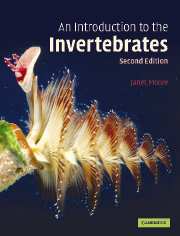Book contents
- Frontmatter
- Contents
- List of boxes
- Preface
- Acknowledgements
- Illustration acknowledgements
- Chapter 1 The process of evolution: natural selection
- Chapter 2 The pattern of evolution: methods of investigation
- Chapter 3 Porifera
- Chapter 4 Cnidaria
- Chapter 5 On being a worm
- Chapter 6 Platyhelminthes and Acoelomorpha
- Chapter 7 Nemertea
- Chapter 8 Nematoda
- Chapter 9 Annelida
- Chapter 10 Mollusca: general and Gastropoda
- Chapter 11 Mollusca: Bivalvia and Cephalopoda
- Chapter 12 Arthropoda: general
- Chapter 13 Crustacea
- Chapter 14 Chelicerata and Myriapoda
- Chapter 15 Insecta
- Chapter 16 Animals with lophophores
- Chapter 17 Echinodermata
- Chapter 18 Invertebrate Chordata and Hemichordata
- Chapter 19 Development
- Chapter 20 Invertebrate evolutionary history
- Further reading
- Glossary
- Index
Chapter 10 - Mollusca: general and Gastropoda
Published online by Cambridge University Press: 05 September 2012
- Frontmatter
- Contents
- List of boxes
- Preface
- Acknowledgements
- Illustration acknowledgements
- Chapter 1 The process of evolution: natural selection
- Chapter 2 The pattern of evolution: methods of investigation
- Chapter 3 Porifera
- Chapter 4 Cnidaria
- Chapter 5 On being a worm
- Chapter 6 Platyhelminthes and Acoelomorpha
- Chapter 7 Nemertea
- Chapter 8 Nematoda
- Chapter 9 Annelida
- Chapter 10 Mollusca: general and Gastropoda
- Chapter 11 Mollusca: Bivalvia and Cephalopoda
- Chapter 12 Arthropoda: general
- Chapter 13 Crustacea
- Chapter 14 Chelicerata and Myriapoda
- Chapter 15 Insecta
- Chapter 16 Animals with lophophores
- Chapter 17 Echinodermata
- Chapter 18 Invertebrate Chordata and Hemichordata
- Chapter 19 Development
- Chapter 20 Invertebrate evolutionary history
- Further reading
- Glossary
- Index
Summary
‘Life in a shell’ is the molluscan theme; it sounds very restricted. Yet Mollusca constitute a remarkably large and wide-ranging phylum of at least 100 000 species, mostly marine but including many freshwater species and about 10 000 land snails. The shell is used in a variety of ways, or discarded altogether. The molluscan body plan is unique, and can be traced in animals as different as snails, scallops and squids, functioning over an unusually large size range (from a few millimetres to 15 metres). This account first introduces the distinctive body plan and explains how the shell may be used and then, for each of the main groups, indicates how the basic design has become modified and how so many different molluscs manage to make a living.
What is the basic molluscan body plan?
Molluscan groups which (at least primitively) have shells share a unique body plan (Figure 10.1a) The internal organs (‘viscera’) are contained between a ventral muscular creeping foot and a dorsal calcareous shell secreted by an underlying epidermal covering, the mantle. The mouth opens anteriorly into a buccal cavity with a small sac containing the radula, a rasping tongue covered in teeth made of chitin, a distinctive feature unique to molluscs. The mantle tends to overhang the body as a pair of double-walled folds, leaving posteriorly a space filled with ambient water. This mantle cavity contains the ‘ctenidium’ (morphological term) or ‘gill’ (a name indicating its respiratory function).
- Type
- Chapter
- Information
- An Introduction to the Invertebrates , pp. 120 - 134Publisher: Cambridge University PressPrint publication year: 2006
- 1
- Cited by



